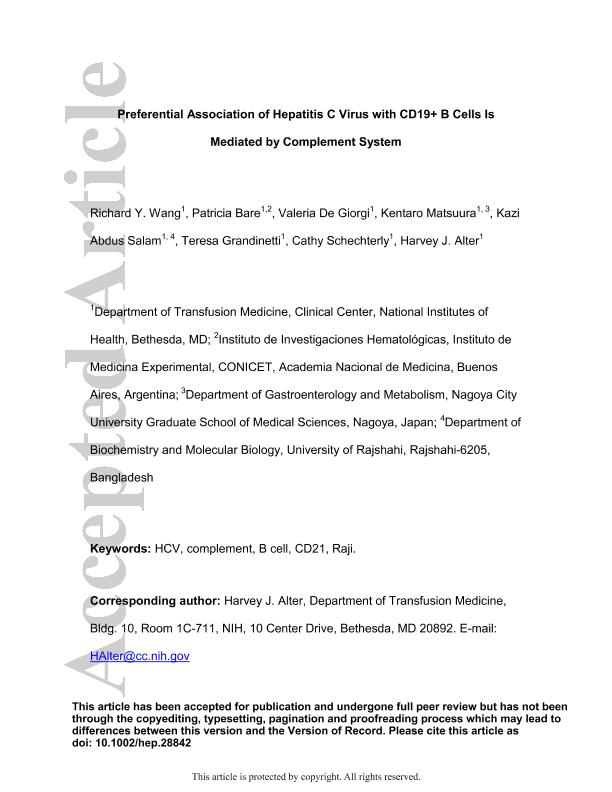Mostrar el registro sencillo del ítem
dc.contributor.author
Wang, Richard
dc.contributor.author
Baré, Patricia

dc.contributor.author
De Giorgi, Valeria
dc.contributor.author
Matsuura, Kentaro
dc.contributor.author
Salam, Kazi Abdus
dc.contributor.author
Grandinetti, Teresa
dc.contributor.author
Schechterly, Cathy
dc.contributor.author
Alter, Harvey J.
dc.date.available
2018-05-13T18:08:29Z
dc.date.issued
2016-09-19
dc.identifier.citation
Wang, Richard; Baré, Patricia; De Giorgi, Valeria; Matsuura, Kentaro; Salam, Kazi Abdus; et al.; Preferential association of hepatitis C virus with CD19+ B cells is mediated by complement system; Wiley-liss, Div John Wiley & Sons Inc; Hepatology; 64; 6; 19-9-2016; 1900-1910
dc.identifier.issn
0270-9139
dc.identifier.uri
http://hdl.handle.net/11336/45019
dc.description.abstract
Extrahepatic disease manifestations are common in chronic hepatitis C virus (HCV) infection. The mechanism of HCV-related lymphoproliferative disorders is not fully understood. Recent studies have found that HCV in peripheral blood mononuclear cells (PBMCs) from chronically infected patients is mainly associated with CD19+ B cells. To further elucidate this preferential association of HCV with B cells, we used in vitro cultured virus and uninfected PBMCs from healthy blood donors to investigate the necessary serum components that activate the binding of HCV to B cells. First, we found that the active serum components were present not only in HCV carriers, but also in HCV recovered patients and HCV negative healthy blood donors and that the serum components were heat labile. Second, the preferential binding activity of HCV to B cells could be blocked by anti-complement C3 antibodies. In experiments with complement-depleted serum and purified complement proteins, we demonstrated that complement proteins C1, C2, and C3 were required to activate such binding activity. Complement protein C4 was partially involved in this process. Third, using antibodies against cell surface markers, we showed that the binding complex mainly involved CD21 (complement receptor 2), CD19, CD20, and CD81; CD35 (complement receptor 1) was involved but had lower binding activity. Fourth, both anti-CD21 and anti-CD35 antibodies could block the binding of patient-derived HCV to B cells. Fifth, complement also mediated HCV binding to Raji cells, a cultured B cell line derived from Burkitt´s lymphoma.CONCLUSION:In chronic HCV infection, the preferential association of HCV with B cells is mediated by the complement system, mainly through complement receptor 2 (CD21), in conjunction with the CD19 and CD81 complex. This article is protected by copyright. All rights reserved.
dc.format
application/pdf
dc.language.iso
eng
dc.publisher
Wiley-liss, Div John Wiley & Sons Inc

dc.rights
info:eu-repo/semantics/openAccess
dc.rights.uri
https://creativecommons.org/licenses/by-nc-sa/2.5/ar/
dc.subject
Hepatitis C
dc.subject
Leucocytes
dc.subject
B-Limphocytes
dc.subject
Cd19
dc.subject
Hepacivirus
dc.subject.classification
Bioquímica y Biología Molecular

dc.subject.classification
Medicina Básica

dc.subject.classification
CIENCIAS MÉDICAS Y DE LA SALUD

dc.subject.classification
Patología

dc.subject.classification
Medicina Básica

dc.subject.classification
CIENCIAS MÉDICAS Y DE LA SALUD

dc.title
Preferential association of hepatitis C virus with CD19+ B cells is mediated by complement system
dc.type
info:eu-repo/semantics/article
dc.type
info:ar-repo/semantics/artículo
dc.type
info:eu-repo/semantics/publishedVersion
dc.date.updated
2018-04-16T14:28:13Z
dc.identifier.eissn
1527-3350
dc.journal.volume
64
dc.journal.number
6
dc.journal.pagination
1900-1910
dc.journal.pais
Estados Unidos

dc.journal.ciudad
Baltimore
dc.description.fil
Fil: Wang, Richard. National Institutes of Health; Estados Unidos
dc.description.fil
Fil: Baré, Patricia. Consejo Nacional de Investigaciones Científicas y Técnicas. Instituto de Medicina Experimental. Academia Nacional de Medicina de Buenos Aires. Instituto de Medicina Experimental; Argentina. National Institutes of Health; Estados Unidos
dc.description.fil
Fil: De Giorgi, Valeria. National Institutes of Health; Estados Unidos
dc.description.fil
Fil: Matsuura, Kentaro. Nagoya City University Graduate School of Medicine; Japón. National Institutes of Health; Estados Unidos
dc.description.fil
Fil: Salam, Kazi Abdus. National Institutes of Health; Estados Unidos. University of Rajshahi; India
dc.description.fil
Fil: Grandinetti, Teresa. National Institutes of Health; Estados Unidos
dc.description.fil
Fil: Schechterly, Cathy. National Institutes of Health; Estados Unidos
dc.description.fil
Fil: Alter, Harvey J.. National Institutes of Health; Estados Unidos
dc.journal.title
Hepatology

dc.relation.alternativeid
info:eu-repo/semantics/altIdentifier/doi/http://dx.doi.org/10.1002/hep.28842.
dc.relation.alternativeid
info:eu-repo/semantics/altIdentifier/url/https://aasldpubs.onlinelibrary.wiley.com/doi/full/10.1002/hep.28842
dc.relation.alternativeid
info:eu-repo/semantics/altIdentifier/pmid/27641977
dc.relation.alternativeid
info:eu-repo/semantics/altIdentifier/url/https://www.ncbi.nlm.nih.gov/pmc/articles/PMC5115962/
Archivos asociados
